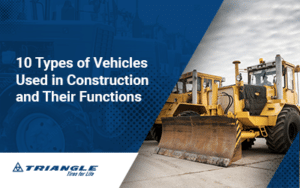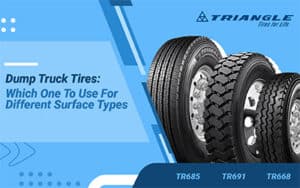The construction industry relies intensely on various heavy machinery to do the job. You can broadly classify these robust machines into two distinct categories: wheeled and tracked vehicles.
If you’re in the process of updating your construction company’s fleet of vehicles, the debate regarding tracks vs. wheels is perhaps something you have heard before.
Choosing between tracks and wheels is a crucial decision that might overwhelm you. Read on to find out how one vehicle differs from the others and what factors you should consider.
What are Tracked Construction Vehicles?
Tracked construction vehicles are easily distinguishable by their tank-like appearance, featuring two parallel tracks instead of traditional wheels. This design choice is no accident; it provides distinct advantages in various construction scenarios.
Advantages:
- Enhanced traction – With more surface area in contact with the ground, tracked vehicles offer superior traction for challenging terrains.
- Improved weight distribution – Reduced ground pressure minimizes the risk of sinking in mud or soft ground, ensuring stability.
- Zero-turn radius – Tracked vehicles boast exceptional maneuverability, enabling them to pivot in place, even in tight spaces.
Disadvantages:
- Increased maintenance – Tracked vehicles have many moving parts, which can lead to higher maintenance requirements.
- Impact on paved roads – The tracks can damage paved roads, making these vehicles unsuitable for road construction.
- Transportation challenges – Track equipment often requires transportation via trailers, which adds complexity to logistics.
What are Wheeled Construction Vehicles?
In contrast to their tracked counterparts, wheeled construction vehicles feature a classic appearance with wheels, albeit larger and reinforced with more rigid materials. These wheels provide a range of benefits and considerations essential for various construction tasks.
Advantages:
- Road-friendly – Wheeled vehicles don’t damage paved roads, making them ideal for projects where surface preservation is vital.
- Reduced maintenance – With fewer moving parts, they generally require less maintenance, saving time and costs.
- Affordability – Generally, wheeled construction vehicles are budget-friendly for initial investments.
Disadvantages:
- Tire vulnerability – Sharp objects at the construction site can puncture rubber tires, requiring replacements and potential downtime.
- Off-road limitations – While wheeled vehicles are capable of going off-road, they may get stuck in the mud and perform poorly in inclines or declines.
- Uneven weight distribution – Wheeled vehicles may have less even weight distribution, impacting stability in certain conditions.
Tracks vs. Wheels: 7 Factors to Consider
Selecting tracks or wheels for construction vehicles can significantly impact project efficiency, cost-effectiveness, and overall success. To help you decide, here are some vital factors that should guide your choice of construction equipment.
1. Mobility and transport
Tracked vehicles excel in challenging terrains. Their broad surface area provides superior traction, making them ideal for muddy, uneven, or slippery ground conditions. However, handling them can be complex since you must transport them via trailers.
Wheeled vehicles are road-friendly and easier to transport from site to site. They’re a practical choice when projects require frequent mobility or involve highway travel.
2. Terrain adaptability
Tracked construction vehicles perform well in rough and uneven terrains. Their weight distribution minimizes the risk of sinking in mud or soft ground, ensuring stability.
On the other hand, wheels are less capable for off-road and might struggle in challenging conditions, making them a better choice for well-paved sites instead.
3. Ground impact
The continuous tracks on tracked vehicles can cause damage to paved roads or delicate surfaces, so you must consider their impact on ground integrity. Wheeled transport doesn’t have this concern, making them ideal for projects where preserving the quality of the ground is paramount.
4. Maneuverability
Tracked vehicles operate exceptionally well in tight spaces thanks to their zero-turn radius, allowing for easy pivoting and agile maneuvering.
However, their wheeled counterparts offer flexibility in urban or confined areas due to their steering systems. But they are less adept at navigating around obstacles and construction sites.
5. Speed
Although powerful, tracked vehicles tend to have slower speeds. They might not be the best choice for projects requiring rapid transportation. Wheeled vehicles can achieve higher paces, making them suitable for tasks that demand efficient and speedy movement.
6. Cost
Tracked vehicles have higher initial costs and maintenance needs than wheeled vehicles, which are generally more budget-friendly upfront and require less maintenance. As such, the latter may be the cost-effective choice for small-scale projects.
7. Maintenance
Tracks come with more moving parts, which can lead to increased maintenance requirements. Wheels are easier to repair or replace as they are more widely available. However, both require investing in quality construction wheels critical for long-lasting performance and safety on a hectic construction site.
Rolling Toward the Right Choice
In the tracks vs. wheels debate, the choice is far from one-size-fits-all. The main takeaway is that your chosen construction vehicle depends on the specific demands of your projects.
Tracked vehicles offer exceptional performance on challenging terrains, while wheeled vehicles are road-friendly, speedy, and cost-effective solutions. Careful consideration of all the factors will lead you to the option that aligns perfectly with your needs.
Above all, you should use quality equipment in your site to improve your output while keeping your workers safe. Are you looking for quality tires to enhance the performance of your construction equipment? Triangle Tires has you covered with a diverse range of options. Browse our tire catalog or contact us for personalized assistance.


